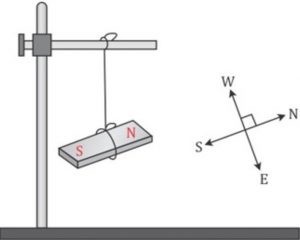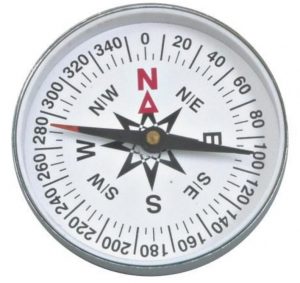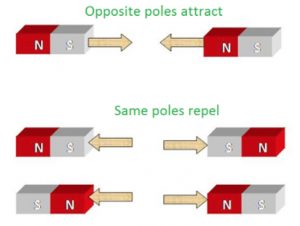Question 1 What is a compass?
Question 2 Describe the construction of a compass?
Question 3 State two properties of magnets?
Question 4 State few uses of magnetic compass?
Question 5 Why a freely suspended magnet (or a freely pivoted magnet) always points in the same direction?
Question 6 You are given a bar magnet whose N and S poles are not marked? Describe briefly how you would you find out the poles?
Also Read NCERT Solutions for Chapter 13 Fun with Magnets
Contents
Two most important properties of magnets
(1) A freely suspended magnet always points in the north-south direction.
(2) Like magnetic poles repel each other; unlike magnetic poles attract each other.
A Freely Suspended Magnet Always Points in North-South Direction
If a bar magnet is freely suspended, it will swing until its one end points towards the north pole of the earth and the other towards the south pole of the earth. A freely suspended magnet comes to rest always in the north-south direction. We call it a freely suspended magnet because it is free to move in any direction. If we turn the magnet by hand so that it points in another direction and then leave it. We will see that after a while the magnet comes back to its earlier position and again points in the same north-south direction.
The end of magnet which points towards the north direction is called north-seeking end or north pole of the magnet.
The end of magnet which points towards the south direction is called south-seeking end or south pole of the magnet.
It is only a freely suspended magnet (or a freely pivoted magnet) which always comes to rest along the same direction (north-south direction) even after being disturbed again and again.
The four major directions are North, South, East and West. These are denoted by the letters N, S, E and W respectively. We can have four more directions as: North-East (NE), North-West (NW), South-East (SE) and South-West (SW).
North-East is midway between North and East directions.
North-West is midway between North and West directions.
South-East is midway between South and East directions.
South-West is midway between South and West directions.
The sun always rises in the morning from the East direction. So, if we stand facing the morning sun rising from the East direction with both the arms extended on sides, then our left arm will point towards North and the right arm will point towards South.
Finding Directions
The property of a freely suspended magnet to align itself always along the North-South of the earth is used to find directions at unknown places.
(1) For centuries, travellers on land and at sea have been using this property of magnets to find directions.
(2) In olden days, travellers to far off places used to carry natural magnets (which were strips of magnetite) and thread with them. They used to find directions along their way by suspending the natural magnet with a thread.
When artificial magnets were available, an instrument (or device) called compass was developed to find the directions more conveniently. In a compass, the magnet is not suspended from a thread. The tiny magnet in a compass is free to turn (or rotate) on a pivot or pin. It is called freely pivoted magnet. Just like a freely suspended magnet, a freely pivoted magnet also always comes to rest along the north-south direction.
(1) The compass is an instrument to find the directions at a place. The compass is based on the property of a freely pivoted magnet to align itself along the north-south direction.
(2)The compass has a tiny magnet in the form of a needle which can rotate freely on a pivot (or pin).
(3)The pivoted magnetic needle of the compass is enclosed in a small brass box having a glass top.
(4) The compass has a circular dial with various directions marked on it. The needle of compass always comes to rest along the north-south direction.
(5)The north pole of compass needle is painted with a different colour to distinguish it from the south pole.
(6) To find the directions at a place, the compass is kept on a flat surface at that place. The needle of compass will soon come to rest (or become stationary) along the north-south direction. The compass is then rotated until the painted end of needle is towards N mark on the dial and the other end of needle is towards S (South) mark on the dial.
Uses of Compass
(1) Compass is used by soldiers in the jungle to find direction for their movement.
(2) The compass is also used by sailors while at sea so as to take their ships in the right direction.
Why a freely suspended magnet (or a freely pivoted magnet) always points in the same direction : north-south direction.
Our planet earth also shows magnetism. The earth behaves as if a giant bar magnet is buried at its centre. It is the force exerted by the earth’s imaginary magnet which acts on a freely suspended bar magnet (or freely pivoted magnetic needle of a compass)y and makes them always point in the north-south direction.
Attraction and Repulsion between Magnets
Whether a magnet will attract or repel another magnet depends on which poles of the magnets are facing each other.
(1) When we place two magnets in such a way that the north pole of one magnet faces the north pole of other magnet, they repel (push away) each other. Similarly, when the two magnets are placed near each other in such a way that south pole of one magnet faces the south pole of the other magnet, even then they repel (push away) each other.
Since north-north poles and south-south poles are like poles, we can say that like poles (or similar poles) repel each other.
(2) If we place two magnets near each other in such a way that the north pole of one magnet faces the south pole of the other magnet, they attract each other (and come near to each other).Since north pole and south pole are unlike poles, we can say that unlike poles attract each other.
ACTIVITY
Let us bring the north pole of the hand-held magnet near the north pole of the suspended magnet.
We will find that the north pole of the suspended magnet moves away from the north pole of our hand-held magnet. This means that the north pole of one magnet repels the north pole of the other magnet.
If we bring the south pole of the hand-held magnet near the south pole of the suspended magnet, even then the south pole of suspended magnet moves away showing that the south pole of one magnet repels the south pole of another magnet.
We now bring the south pole of the hand-held magnet near the north pole of the suspended magnet. We find that the north pole of the suspended magnet moves towards the south pole of our hand-held magnet. This means that the south pole of one magnet attracts the north pole of another magnet.
The above activity shows that:
(1) N pole brought near to N pole repels.
(2) S pole brought near to S pole repels.
Like magnetic poles repel each other
(1) N pole brought near to S pole attracts.
(2) S pole brought near to N pole attracts.
Unlike magnetic poles attract each other
If two magnets are brought close together then like magnetic poles will repel each other and unlike magnetic poles will attract each other.
The needle of a compass always aligns itself along the same direction :north-south direction. The needle of a compass is itself a tiny magnet (having a N-pole and a S-pole) which is free to rotate on a pivot.When another magnet is brought near a compass, then this magnet will attract or repel the magnetic needle of compass due to which the compass needle will be disturbed from its usual north-south direction. The compass needle will point in another direction.
If we take the magnet away from compass, the compass needle will come back to its original north-south position.
The various devices and appliances such as mobile phones, music systems, television sets, computers, compact discs (CDs), cassettes and credit cards, etc., use magnetism for their working.So, we should keep strong magnets away from all these devices so as not to disturb their working.
| Notes for Chapter 13 Fun with Magnets |



Very helpful. Thanks so much
So educative